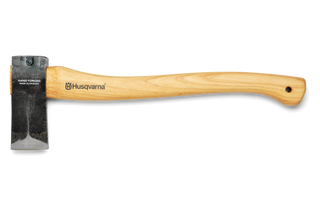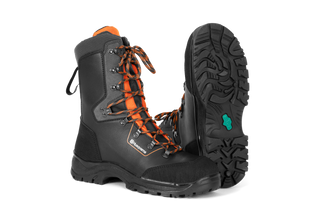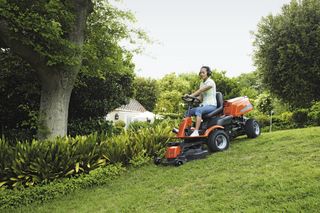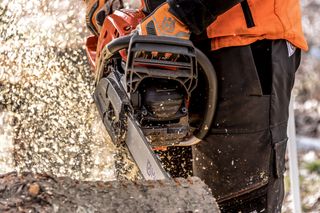
Chopping wood – How to chop wood
Wood is one of the oldest sources of energy known to man. And with rising energy prices, wood burning has gained renewed relevance – not just as a cosy feature but to heat homes. Here are some tips that make it easier and safer to chop wood – or rather to split it.
There is a risk of conceptual confusion when talking about cutting wood. Forestry professionals often mean felling trees, while homeowners with wood-burning stoves who talk about cutting wood often mean splitting it. But why do you split wood? Well, it's simply to dry it before it can be burned.
Firewood must dry
Fresh wood contains about 45% water, and the splitting means that it dries better because the bark and birch bark act as a moisture barrier and lock in the moisture. Trees that have been felled and cut for firewood in the late winter cannot be used until the autumn of the same year at the earliest – ideally, it should lie and dry throughout the autumn and winter as well. It is important to only burn with dry wood, as wet wood produces poorer burning and less heat. In addition, soot and tar are formed, which get stuck in the chimney and produce unhealthy emissions. The moisture content of combustible firewood is 15 – 20%. When stacking, keep in mind that the wood dries better if it is stacked with the remaining bark facing down.
Cutting birch wood in the summer?
Whether you use a chainsaw or other tools, the best time for felling for firewood is when the logs are at their driest, which is during late winter and early spring. If you order home uncut wood and have it delivered during this period, you start by cutting the logs into suitable lengths. Preferably use a wooden sawhorse, which facilitates the cutting and provides more precision. Then it's just a matter of starting to split. Be careful to cut the wood straight, as placing a diagonally cut log on the chopping block is difficult or impossible. The easiest way is to split the wood fairly soon after the trees have been felled. If left for too long, it becomes tough and harder to split.
If birch wood is felled during the summer, it is good if the leaves remain before the wood is cut and split. They draw out the sap and make the wood dry faster. After a month or so, the leaves have turned yellow, and you can cut and split the wood into suitable firewood. Of course, it is also OK to split firewood in autumn. The air is usually dry during the winter, which provides good conditions for the wood to dry.
Which firewood is best?
How much energy the wood provides depends on how and where the tree has grown. Generally speaking, trees that have grown slowly on dry soil have a higher density, and thus a higher energy content, than trees that have grown on moist soil. The heating value also differs between the different parts of the tree, depending on the levels of fats and resins in the wood.
When it comes to energy content per cubic meter, the heavier types of wood are at the top: beech, oak and ash tree burn for a long time and give a nice glow. Birch gives 2660 kWh/m3 while beech gives 3032 kWh/m3, which is only surpassed by lilac, which gives a whopping 4500 kWh/m3. However, the lilac is difficult to obtain in large quantities.
Conifers like spruce and pine burn well but give off less heat. Pine provides 2341 kWh/m3, and spruce only 2022 kWh. In addition, wood from conifers releases a lot of sparks and must, therefore, be burned behind hatches or fireguards. Mixing different wood types and burning birch and spruce together is also possible. Softwood is also good for lighting up the fire.
Prepare your wood-splitting
Splitting wood is not very complicated, but it may require some preparation. Use a flat and open surface where you have plenty of space and where others will not come close. A solid chopping block is a must. Make sure it is heavy and stable and stands firmly on a surface that does not spring, as this reduces the power of the cut. The chopping block should not be above knee height.
Place the log to be split upright, as far away from you as possible, on the far edge of the chopping block. The reason is that if you miss, the axe hits the chopping block, and you reduce the risk of hitting the ground or your legs. Hold the axe with straight arms, far out on the axe shaft, and you will get the most power possible. The axe handle should be horizontal when the axe hits the wood.
Big, gnarly logs
If you have large logs or gnarly and twiggy pieces, separating them with just the axe can be difficult. Avoid prying the axe to the sides, as you can damage it and even break the handle. Instead, you may need to use wedges that you drive into the wood with a sledgehammer so that the wood splits. Insert wedge number two further into the crack so it widens, then continue moving the wedges until the entire log splits. Do not use your regular axe for this as it can take damage, only use a sledge axe or sledgehammer.
What kind of axe should you have?
There are different kinds of axes for different purposes, but if you want to buy an axe to split wood as efficiently as possible, you should choose a splitting axe. A larger all-round axe also works, but the advantage of the splitting axe is that it has a shape intended specifically for splitting firewood, making the job considerably easier. A splitting axe has a large, heavy, wedge-shaped head to better split wood. The splitting axe is made to cut along the grain of the wood, unlike the wood axe which is made to cut them. A variant is the sledge axe, whose so-called sledgehammer neck is intended for hitting wedges if you come across unusually gnarly pieces of wood.
Protective measures when cutting wood
It is essential to be careful when splitting wood and to ensure that no one else is near the chopping block while you are at it. A good idea is to wear safety glasses to avoid getting splinters in the eyes and gloves to prevent chafes and hand damage. Steel-toed safety shoes are also good, if only because they protect your toes from falling logs.













